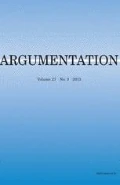Abstract
The presentation of analogical arguments in the critical thinking literature fails to reflect cognitive research on analogy. Part of the problem is that these treatments of analogy do not address counterarguments, an important aspect of the analysis of analogical argumentation. In this paper, I present a taxonomy of four counterarguments, false analogy, misanalogy, disanalogy, and counteranalogy, analyzed along two dimensions, orientation and effect. The counterarguments are treated in the framework of the multiconstraint theory of analogy (Holyoak and Thagard, 1995). This framework is also extended to account for the evidence brought to light by the consideration of counterarguments. The result is a psychologically motivated treatment of analogical arguments that will be useful both for critical and pedagogical purposes.
Similar content being viewed by others
REFERENCES
Alexander, H. G.: The Leibniz-Clarke Correspondence, Manchester University Press, Manchester.
Alvarez, L. W., W. Alvarez, F. Asaro and H. V. Michel: 1980, ‘Extraterrestrial Cause for the Cretaceous-Tertiary Extinction’ Science 208, 1095–1108.
Copi, I. M. and C. Cohen: 2002, Introduction to Logic, 11th edition, Prentice Hall, Upper Saddle River, NJ.
Gentner, D.: 1983, ‘Structure-mapping: A Theoretical Framework’ Cognitive Science 7, 155–170.
Gentner, D. K., J. Holyoak and B. N. Kokinov: 2001, The Analogical Mind: Perspectives from Cognitive Science, MIT Press, Cambridge, MA.
Hesse, M. B.: 1966, Models and Analogies in Science, University of Notre Dame Press, Notre Dame.
Holyoak, K. J. and P. Thagard: 1995, Mental Leaps: Analogy in Creative Thought, MIT Press, Cambridge, MA.
Hume, D.: 1888, A Treatise on Human Nature (L. A. Selby-Bigge, ed.), Oxford University Press, Oxford. (Original work published in 1738-1740.)
Jason, G.: 2001, Critical Thinking: Developing an Effective Worldview, Wadsworth, Belmont, CA.
Kent, D. V.: 1981, ‘Asteroid Extinction Hypothesis’ Science 211, 648–650.
Keynes, J. M., 1921, A Treatise on Probability, Macmillan & Co., London.
Mill, J. S.: 1872, A System of Logic, 8th edition, Longmans, London.
Rescher, N.: 1964, Introduction to Logic, St. Martin's Press, New York.
Shelley, C.: 2002, ‘The Analogy Theory of Disanalogy: When Conclusions Collide’ Metaphor and Symbol 17, 81–97.
Author information
Authors and Affiliations
Rights and permissions
About this article
Cite this article
Shelley, C. Analogy Counterarguments: A Taxonomy for Critical Thinking. Argumentation 18, 223–238 (2004). https://doi.org/10.1023/B:ARGU.0000024025.45062.24
Issue Date:
DOI: https://doi.org/10.1023/B:ARGU.0000024025.45062.24




